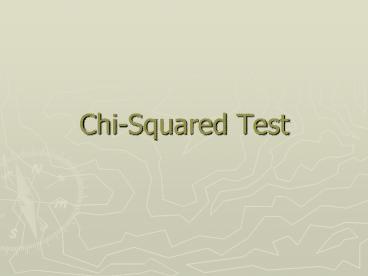Chi-Squared Test - PowerPoint PPT Presentation
1 / 12
Title:
Chi-Squared Test
Description:
Chi-Squared Test Chi-Square Test Compare observed data with data you would expect to obtain according to a specific hypothesis How much deviation can occur before you ... – PowerPoint PPT presentation
Number of Views:454
Avg rating:3.0/5.0
Title: Chi-Squared Test
1
Chi-Squared Test
2
Chi-Square Test
- Compare observed data with data you would expect
to obtain according to a specific hypothesis - How much deviation can occur before you conclude
something other than chance at work? - ?2 S(o-e)2 / e
- Tests the null hypothesis
- States that there is no significant difference
between the expected and observed result
3
Lizard Example
- Male phenologies in a population of side-blotched
lizards - Three male phenotypes
- Very aggressive orange-throat males
- Moderately aggressive blue-throat males
- Sneaker yellow-throat males
- The three phenotypes vary in their frequencies
over time
4
Scientific Hypothesis
- Scientific hypothesis
- The three male phenotypes are present in equal
frequencies in the population - Research question
- Are there differences in the frequencies of male
phenotypes in the population of lizards - Chi-square (goodness of fit)
- How well does our observed frequency distribution
match the expected frequency distribution
5
Step 1
- Determine number of observed and expected in each
category - Obtained a sample of 51 males from the population
- 12 orange-throat males
- 30 blue-throat males
- 9 yellow-throat males
- Expected frequency is 111
- 51/3 17
- We expect 17 of each individuals
6
Step 2
- Calculate X2
Orange Blue Yellow
Observed (o) 12 30 9
Expected (e) 17 17 17
Deviation (o-e) -5 13 -8
Deviation2 (d2) 25 169 64
d2/e 1.47 9.94 3.76
X2 Sd2/e 15.17 X2 Sd2/e 15.17
7
Step 3
- Determine degrees of freedom (df)
- Number of values we can pick freely without being
constrained by other values - Number of categories in the problem minus 1
- Three categories (orange, blue, yellow)
- 2 df
8
Step 4
- Determine a relative standard to serve as the
basis for rejecting the hypothesis - Commonly used in biological research plt0.05
- P value probability of rejecting the null
hypothesis (no difference between observed and
expected) when it is actually true - Probability of making an error of falsely stating
that there is a significant difference between e
and o when there is not a significant difference. - p lt 0.05
- Stating that there is a less than 5 chance of
error of stating there is a difference when there
actually isnt a significant difference
9
Step 5
- Refer to chi-square distribution table
- Locate appropriate df (2)
- Locate the value corresponding to the p value of
0.05
10
Conclusions
- If your X2 gt distribution table
- Conclude observed numbers significantly different
from the expected - X2 (15.17) is greater than 5.99 (df2, p0.05)
- Reject the hypothesis that the three male
phenotypes are present in equal frequencies - Significant difference in frequencies among the
three phenotypes
Degrees of Freedom (df) Probability (p) Probability (p) Probability (p) Probability (p) Probability (p) Probability (p) Probability (p) Probability (p) Probability (p) Probability (p) Probability (p)
Degrees of Freedom (df) 0.95 0.90 0.80 0.70 0.50 0.30 0.20 0.10 0.05 0.01 0.001
1 0.004 0.02 0.06 0.15 0.46 1.07 1.64 2.71 3.84 6.64 10.83
2 0.10 0.21 0.45 0.71 1.39 2.41 3.22 4.60 5.99 9.21 13.82
3 0.35 0.58 1.01 1.42 2.37 3.66 4.64 6.25 7.82 11.34 16.27
4 0.71 1.06 1.65 2.20 3.36 4.88 5.99 7.78 9.49 13.28 18.47
5 1.14 1.61 2.34 3.00 4.35 6.06 7.29 9.24 11.07 15.09 20.52
Nonsignificant Nonsignificant Nonsignificant Nonsignificant Nonsignificant Nonsignificant Nonsignificant Nonsignificant Significant Significant Significant
11
Plant and Environment Interaction
- Galapagos Tree Fern
- Present in 4 life zones on the islands
- Miconia Zone
- Brown Zone
- Scalesia Zone
- Transition Zone
12
- Hypothesis
- The cactus tree fern is present in equal
frequencies across the life zones - Observed data
- Miconia Zone - 13
- Brown Zone - 15
- Scalesia Zone - 22
- Transition Zone - 18































